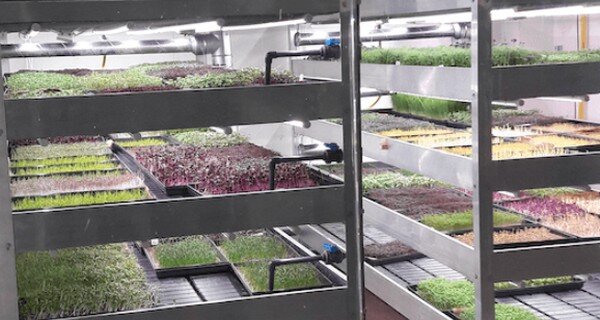
Welcome to iGrow News, Your Source for the World of Indoor Vertical Farming
Why Are Microgreens Often Referred To As Cash Crops?
Microgreens sell at high prices to specific niches: chefs, foodies or just people who pursue a healthy lifestyle because their exceptionally high nutrient density attracts customers who choose a healthy lifestyle. They contain higher vitamin, mineral, and antioxidant levels than mature vegetables
July 14, 2021
Food prices have been dropping for a couple of decades. These days they are barely covering the costs of a farming business. Microgreens in particular are an exception to this paradigm. If you grow smart, these little shoots can help create a very profitable operation.
Smart Farmers elaborates on how growing microgreens can be profitable.
Microgreens sell at high prices to specific niches: chefs, foodies, or just people who pursue a healthy lifestyle because their exceptionally high nutrient density attracts customers who choose a healthy lifestyle. They contain higher vitamin, mineral, and antioxidant levels than mature vegetables. In fact, research comparing microgreens to their mature counterparts report that nutrient levels can be up to 40x higher.
Besides, the flavor of microgreens is so intense that chefs and foodies go nuts over these babies. In addition, they are perfect to use as plate decorations and come in many different varieties. If you decide to only grow microgreens, you’ll still be able to offer a wide variety of products. There are at least 25 types that are commercially popular, and the market still allows for more exploration.
A big advantage for growers is that they can provide up to 35 harvests per year. Depending on the variety, microgreens only need 1 to 2 weeks to grow. Even if for some reason, something goes wrong with a batch, you won’t miss out on an entire seasonal income.
Read the complete article at: Vertical Farm Daily:
For more information:
Smart farmers
www.smartfarmers.eu
Global Food Prices Rise For 10th Month In A Row
The FAO Food Price Index, which tracks monthly changes in the international prices of commonly-traded food commodities, averaged 118.5 points in March, 2.1 percent higher than in February and reaching its highest level since June 2014
Vegetable Oils Drive FAO Food Price Index
Higher In March While Cereal Quotations Dip
Packing butter in the Russian Federation.
8 April 2021, Rome - Global food commodity prices rose in March, marking their tenth consecutive monthly increase, with quotations for vegetable oils and dairy products leading the rise, the Food and Agriculture Organization of the United Nations (FAO) reported today.
The FAO Food Price Index, which tracks monthly changes in the international prices of commonly-traded food commodities, averaged 118.5 points in March, 2.1 percent higher than in February and reaching its highest level since June 2014.
Trends varied by commodity types. The March increase was led by the FAO Vegetable Oil Price Index, which rose 8.0 percent from the previous month to hit a nearly 10-year high, with soy oil prices rising sharply due in part to the prospects of firm demand from the biodiesel sector.
The FAO Dairy Price Index increased 3.9 percent from February, with butter prices buoyed by somewhat tight supplies in Europe associated with increased demand in anticipation of a food-service sector recovery. Milk powder prices also rose, supported by a surge in imports in Asia, particularly China, due to declining production in Oceania and scarce shipping container availability in Europe and North America.
The FAO Meat Price Index also rose, by 2.3 percent from February, with imports by China and a surge in internal sales in Europe ahead of the Easter holiday celebration underpinning increasing poultry and pig meat quotations. Bovine meat prices remained steady, while ovine meat prices declined as dry weather in New Zealand led to farmers offloading animals.
By contrast, the FAO Cereal Price Index dropped by 1.8 percent, but it is still 26.5 percent higher than in March 2020. Wheat export prices declined the most, reflecting generally good supplies and favorable production prospects for 2021 crops. Maize and rice prices also declined, while those for sorghum rose.
The FAO Sugar Price Index declined 4.0 percent in the month, triggered by prospects of large exports from India, but it remained more than 30 percent above its year-earlier level.
Positive cereal crop prospects in 2021
FAO expects world cereal production in 2021 to increase for the third consecutive year and has raised its preliminary global wheat production forecast on better than-earlier-anticipated crop conditions in several countries. Global wheat production is forecast to reach a new high of 785 million tonnes in 2021, up 1.4 percent from 2020, driven by a likely sharp rebound across most of Europe and expectations of a record harvest in India.
Above-average outputs are also expected for maize, with a record harvest anticipated in Brazil and a multi-year high in South Africa, according to FAO's Cereal Supply and Demand Brief, also released today.
For the current 2020/21 marketing season, global cereal utilization is now forecast at 2 777 million tonnes, 2.4 percent higher than the previous year, driven largely by higher estimates of feed use of wheat and barley in China, where the livestock sector is recovering from African swine fever.
World cereal stocks at the end of 2021 are forecast to decline by 1.7 percent from their opening levels to 808 million tonnes. Combined with the utilization forecasts, the global cereal stock-to-use ratio for 2020/21 is foreseen to dip to a seven-year low of 28.4 percent.
FAO also raised its forecast for world trade in cereals during 2020/21 to 466 million tonnes, a 5.8 percent increase from the previous year, driven by even faster trade in coarse grains linked to unprecedented levels of maize purchases by China. Also for rice, international trade is forecast to expand by 6 percent year-on-year.
The Brief offers more details and updated assessments.






